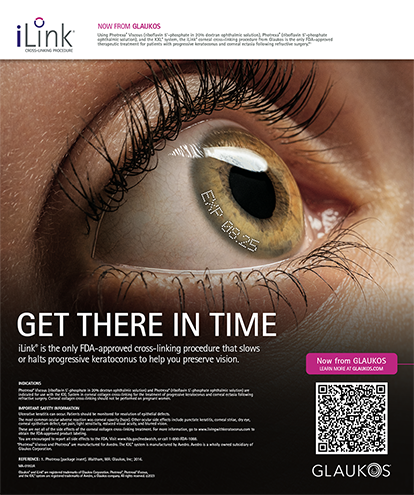
Clinical Outcomes of a New Extended Range of Vision Intraocular Lens: International Multicenter Concerto Study
Cochener B for the Concerto Study Group1
ABSTRACT
The Concerto Study Group conducted an international multicenter study to evaluate the performance of the new Tecnis Symfony IOL (Abbott). The study included 40 sites in Finland, France, Germany, Norway, Spain, Sweden, and the United Kingdom. Four hundred eleven patients were enrolled in the study after bilateral implantation of the lens. The preoperative visit and surgery were documented retrospectively, whereas the postoperative visits were recorded prospectively. The patients consisted of two subgroups: one targeted for micromonovision (0.50-0.75 D) and one for emmetropia. Patients with any ocular conditions affecting their visual potential were excluded.
AT A GLANCE
- The international, multicenter Concerto Study provides the first look at the performance of an extendedrange- of-vision lens based on diffractive achromatic technology. Investigators found that the Tecnis Symfony IOL successfully provided vision and achieved a high level of spectacle independence at all distances.
- In a study involving 340 emmetropic presbyopic patients across 11 sites, the Raindrop Near Vision Inlay offered excellent intermediate and near vision while maintaining binocular distance vision and contrast sensitivity.
Surgeries were performed with standard or femtosecond laser-assisted phacoemulsification. The researchers assessed visual outcomes based on binocular uncorrected and corrected distance visual acuity, uncorrected intermediate visual acuity, and uncorrected near visual acuity. They recorded patients’ responses to questions regarding their spectacle dependence at near, intermediate distance, and distance; their experience of glare, halos, starbursts, or other visual disturbances; and their satisfaction with their vision. The set of questions was not specifically validated. The investigators also collected surgeons’ feedback on the procedure, visual outcomes, and achievement of the target refraction.
The researchers found that uncorrected distance vision was comparable (0.03-0.04 logMAR) between the monovision and emmetropic cohorts. The monovision group had statistically significantly better uncorrected intermediate and near vision than the emmetropic subset. The mean uncorrected intermediate and near visual acuity for the monovision group was 0.09 and 0.17 logMAR, respectively; for the emmetropic group, these values were 0.21 and 0.13 logMAR. This translated to greater spectacle independence for near activities for the monovision group. More than 90% of patients reported no or mild glare, halos, starbursts, and other photic phenomena. Patients and surgeons gave high satisfaction ratings, with 94.4% of patients saying they would choose the same IOL again.
The study concluded that the Tecnis Symfony IOL as an extended-range-of-vision IOL succeeds in providing vision and achieving a high level of spectacle independence at all distances.
DISCUSSION
The Concerto Study provides the first look at the performance of an extended-range-of-vision lens based on diffractive achromatic technology. The Tecnis Symfony IOL is designed to correct ocular chromatic aberration, thereby reducing blurring and changes in contrast sensitivity. Unlike a multifocal lens, the extended-range IOL has an elongated focal area for clear vision instead of multiple foci.
In the study, the Tecnis Symfony IOL successfully restored vision at multiple distances with a much lower incidence of photic phenomena such as glare, halos, and starbursts compared with multifocal IOLs. Although the former does not have multiple focal points, it delivers distance, intermediate distance, and near vision comparable to that achieved with multifocal IOLs. The intermediate visual acuity of patients in this study was equal to or better than that achieved with multifocal IOLs, including diffractive bifocal and trifocal IOLs.2-5 With the inclusion of two subsets of patients, the micromonovision and emmetropic groups, the investigators demonstrated that micromonovision with the Symfony offers patients significantly better intermediate and near vision as well as an opportunity for greater spectacle independence compared with targeting bilateral emmetropia.
The Tecnis Symfony IOL breaks new ground in the treatment of presbyopia. Its unique design—the achromatic diffractive echelette—allows correction of chromatic and spherical aberration. Unlike other presbyopia-correcting IOLs, this lens offers the benefits of multifocal correction while minimizing the incidence of glare, halos, and reduced contrast sensitivity. This has translated in practice to high rates of satisfaction among patients. Long-term results with the technology will be of great interest.
Treatment of Presbyopia in Emmetropes Using a Shape-Changing Corneal Inlay
Whitman J, Dougherty PJ, Parkhurst, et al6
ABSTRACT
Whitman and colleagues reported the clinical outcomes and safety of the Raindrop Near Vision Inlay (ReVision Optics). Three hundred forty emmetropic presbyopic patients across 11 sites had the implant placed in the cornea of their nondominant eye. Inclusion criteria were a reading power of +1.50 to +2.50 D, refractive astigmatism of 0.75 D or less, a spherical equivalent of -0.50 to 1.00 D, and a pachymetry reading of 500 µm or more. Corrected distance and near visual acuity was 20/20 preoperatively. Prior to implantation of the inlay, patients underwent a multifocal contact lens trial in the nondominant eye.
In all cases, using a femtosecond laser, the surgeon created a corneal flap with a diameter greater than 8 mm and a thickness of between 140 and 180 µm. After lifting the flap to the hinge, the surgeon placed the inlay and centered it over the pupil.
Prior to implantation of the inlay, mean monocular corrected distance vision was 20/20, with all subjects seeing 20/25 or better. Three months after surgery, mean monocular corrected distance vision was 20/20, with 99% of patients seeing 20/25 or better. At 1 year, mean corrected distance vision remained 20/20, with 99% of subjects seeing 20/25 or better. Uncorrected near vision prior to surgery was 20/50 or worse in 99% of subjects. Three months postoperatively, 93% of the population could see 20/25 at near, and this result was sustained at 1 year. Preoperative intermediate vision was variable, with 53% of subjects seeing 20/40 or better. One week after surgery, 76% of patients saw 20/32 or better. At 3 months, 97% of the subjects had attained an intermediate visual acuity of 20/32, a result sustained at 1 year.
The investigators measured contrast sensitivity at distance under photopic and mesopic lighting conditions. The nondominant eye showed a small loss of sensitivity at the highest spatial frequencies, but the change was less than the preoperative standard deviation. Binocular contrast sensitivity had not changed at any spatial frequency postoperatively.
Patients reported high rates of satisfaction after surgery, with 92% somewhat, very, or completely satisfied with their vision compared with 66% prior to surgery with their usual correction. Conversely, 34% of patients reported being somewhat, very, or completely dissatisfied with their correction prior to inlay surgery compared with 8% afterward.
Adverse events in the first 3 months included flap-related issues, IOP spikes, and inlay exchanges for centration. Flap-related events included epithelial defects, misaligned flaps, and mild diffuse lamellar keratitis. Adverse events after this period related primarily to inlay explants. Eighteen inlays had to be replaced, and 11 had to be explanted. The 11 explantations were because of patients’ dissatisfaction, inlay misalignment, epithelial ingrowth, and reduced distance visual acuity.
The investigators concluded that the Raindrop Near Vision Inlay offers excellent intermediate and near vision while maintaining binocular distance vision and contrast sensitivity.
DISCUSSION
Corneal inlays have ushered in a new age of surgical presbyopic correction. The devices offer presbyopic individuals between approximately 40 and 60 years of age the possibility of achieving improved intermediate and near visual acuity without the drawbacks of monovision, including reduced distance acuity, depth perception, and contrast sensitivity. Additionally, inlay surgery eliminates the risks of intraocular surgery that accompany refractive lens exchange with implantation of a multifocal IOL. This study provides data about the 1-year outcomes of the Raindrop Near Vision Inlay. Unlike the Kamra (AcuFocus), which uses a pinhole to provide an extended depth of focus, the Raindrop alters the anterior corneal surface by raising the corneal stroma and epithelium. The subsequent remodeling of the central 3 mm of the corneal epithelium allows near vision through the steep center, intermediate vision in the paracentral region, and distance vision in the periphery.
In this study, the Raindrop maintained distance vision while significantly improving near and intermediate vision. The research also highlights the importance of centration to the success of the inlay. In addition to the refractive performance of the device, the investigators examined the incidence of corneal haze and noted an inverse relationship between haze rate and the depth of the inlay’s implantation. This observation is consistent with the concept of the cornea’s being less reactive at greater depths. Based on the study, the investigators recommended targeting a depth of 31% to 34% of the central corneal thickness to minimize the rate of haze. Inlay surgery can be coupled with myopic or hyperopic laser correction.
Although long-term outcomes of the Raindrop Near Vision Inlay remain to be seen, the device shows much promise for correcting presbyopia in precataract patients.
1. Cochener B; Concerto Study Group. Clinical outcomes of a new extended range of vision intraocular lens: International Multicenter Concerto Study. J Cataract Refract Surg. 2016;42(9):1268-1275.
2. Kretz FTA, Gerl M, Gerl R, et al. Clinical evaluation of a new pupil independent diffractive multifocal intraocular lens with a +2.75 D near addition: a European multicenter study. Br J Ophthalmol. 2015;99:1655-1659.
3. Alio JL, Plaza-Puche AB, Pinero DP, et al. Optical analysis, reading performance, and quality of life evaluation after implantation of a diffractive multifocal intraocular lens. J Cataract Refract Surg. 2011;37:27-37.
4. Kohnen T, Titke C, Bohm M. Trifocal intraocular lens implantation to treat visual demands in various distances following lens removal. Am J Ophthalmol. 2016;161:71-77.
5. Alfonso JF, Fernandez-Vega L, Baamonde MB, et al. Prospective visual evaluation of apodized diffractive intraocular lenses. J Cataract Refract Surg. 2007;33:1235-1243.
6. Whitman J, Dougherty PJ, Parkhurst GD, et al. Treatment of presbyopia in emmetropes using a shape-changing corneal inlay: one-year clinical outcomes. Ophthalmology. 2016;123(3):466-475.




